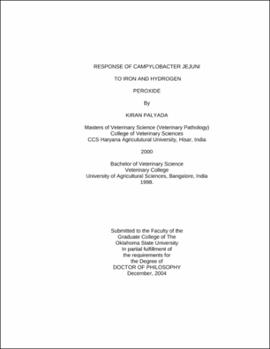| dc.contributor.advisor | Stintzi, Alain | |
| dc.contributor.author | Palyada, Kiran | |
| dc.date.accessioned | 2013-11-26T08:35:16Z | |
| dc.date.available | 2013-11-26T08:35:16Z | |
| dc.date.issued | 2004-12 | |
| dc.identifier.uri | https://hdl.handle.net/11244/7669 | |
| dc.description.abstract | Scope and Method of study: Iron affects the physiology of bacteria in two different ways: as a micronutrient for bacterial growth and as a catalyst for the formation of hydroxyl radicals. The present study reports the response of Campylobacter jejuni to iron and oxidative stresses using DNA microarrays. C. jejuni response to hydrogen peroxide (HP), cumene hydroperoxide (CHP) and menadione was investigated. The response to hydrogen peroxide was investigated both in the presence and the absence of iron. Characterization of the ferric uptake regulator (Fur) and peroxidase regulator (PerR) mutants by transcriptome profiling allowed the identification of Fur and PerR regulated genes, respectively. Chicken colonization model was used to test different C. jejuni mutants for their ability to colonize chicken ceca. | |
| dc.description.abstract | Findings and Conclusions: C. jejuni responded to iron availability by differential expression of genes belonging to several functional groups, ranging from energy metabolism, to cell surface structures, to iron acquisition, and to oxidative stress defense. In addition to identifying several novel iron uptake genes, this study confirmed the function of many genes previously known to be involved in iron acquisition. Directed mutagenesis of several genes identified by microarray experiments allowed the characterization of CfrA as the enterobactin receptor and ChuA as the heme receptor. Both catalase (katA) and alkyl hydroxyperoxidase (ahpC) were induced upon oxidative stress in cells grown in presence of iron while only the catalase was induced in cells grown in absence of iron suggesting an additive effect of iron upon oxidative stress. In contrast to HP and CHP, menadione induced a high number of genes belonging to the DNA repair category suggesting that it is more damaging to the cell than the two other oxidative agents. Mutants in both transcriptional regulators-Fur and PerR were affected in their ability to colonize chicken ceca indicating their important role in the in vivo growth and survival. Further investigation on the numerous gene targets identified in this study would pave way to better understand the patho-physiological mechanism of C. jejuni and might help to develop a drug or vaccine target against this pathogen. | |
| dc.format | application/pdf | |
| dc.language | en_US | |
| dc.rights | Copyright is held by the author who has granted the Oklahoma State University Library the non-exclusive right to share this material in its institutional repository. Contact Digital Library Services at lib-dls@okstate.edu or 405-744-9161 for the permission policy on the use, reproduction or distribution of this material. | |
| dc.title | Response of Campylobacter jejuni to iron and hydrogen peroxide | |
| dc.contributor.committeeMember | Malayer, Jerry | |
| dc.contributor.committeeMember | Ritchey, Jerry | |
| dc.contributor.committeeMember | Prade, Rolf | |
| osu.filename | Palyada_okstate_0664D_1161.pdf | |
| osu.accesstype | Open Access | |
| dc.type.genre | Dissertation | |
| dc.type.material | Text | |
| dc.subject.keywords | iron | |
| dc.subject.keywords | hydrogen peroxide | |
| dc.subject.keywords | Campylobacter jejuni | |
| dc.subject.keywords | oxidative stress | |
| thesis.degree.discipline | Veterinary Pathobiology | |
| thesis.degree.grantor | Oklahoma State University | |
